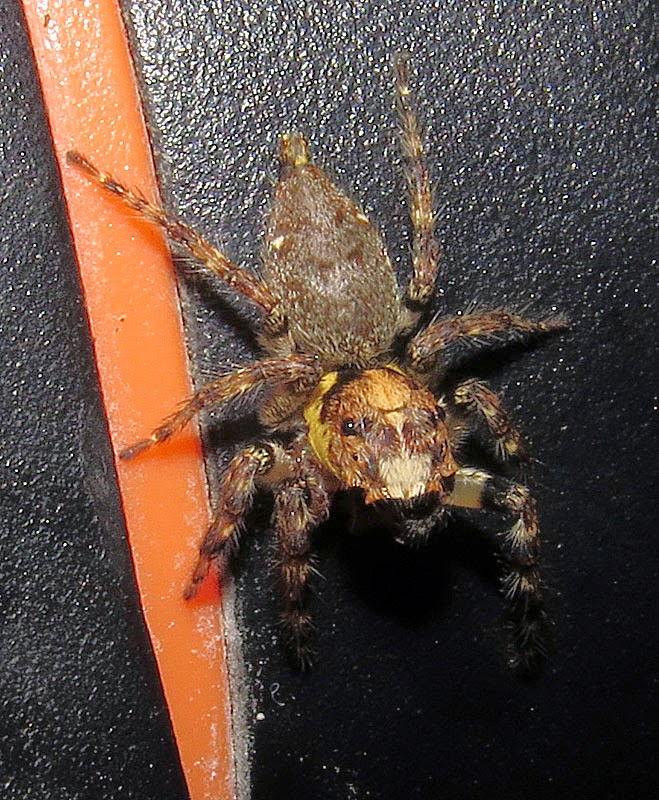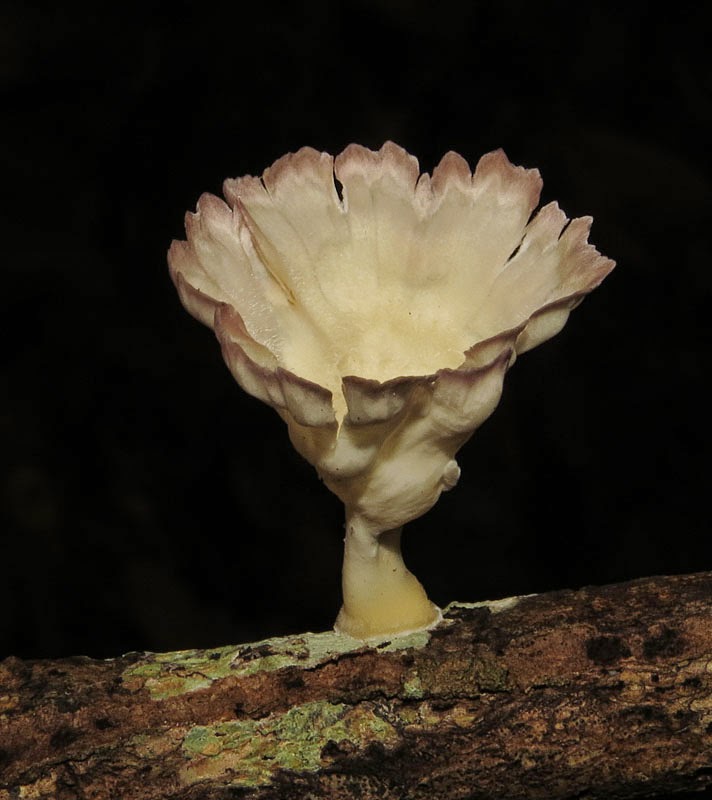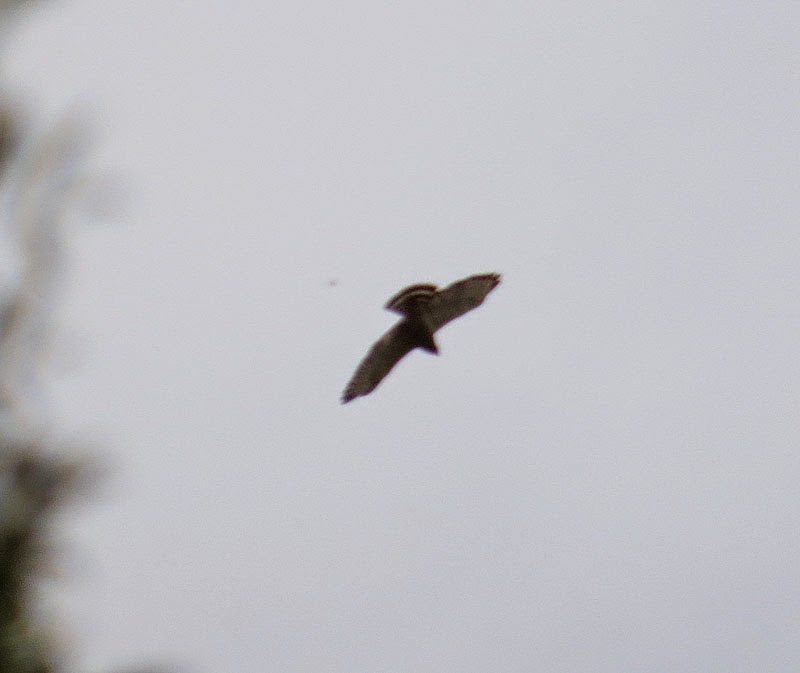This is my blog from the 13th day from
a private tour I led down the Kosñipata Road and the Madre de Dios
River in SE Peru from October 25-November 7. We're at Los Amigos
Biological Station for our last full day, and this morning a low,
heavy overcast seems to be stratified remnants of yesterday's huge
storm.
While the theme every day of this trip
is natural history – today is somehow the day for Cordyceps and
related parasitic/pathogenic fungi. It's something that Susanne is
especially interested in, and up until now we've seen very few. But
at breakfast Nito shares with us an amazing one he found the previous
day. We had talked about it with him, and one of his strong interests
is ants. On the leaf he brought in are two tiny ants infected with
Ophiocordyceps unilateralis, each one having climbed up a tree
and grasped on with their jaws so the fungus has an elevated vantage
to disperse its spores once the animal has died. They're so small, we're
amazed he discovered this, and I have a hard time getting an in-focus
photo.
Notice how the fruiting stalk emerges
from behind the ant's head.
We're off after breakfast and head down
the same trail we took on our first morning; see the blog from two
days ago for the full map. This time we complete the loop I had
contemplated our doing the first time (in red), but after making some
progress, we ended up spending most of the morning along about only
300 meters of the trail, then having to walk fast to get back for
lunch. The blue loop is our afternoon hike.
Part of this morning loop isn't really
an official trail, and here we had to cross a small dam.
I had fun with melastomes on the first
part of the trail. This small tree with odd fruits falling to the
forest floor had me confused at first, but then I noticed the leaf
venation that always tells you Melastomataceae. This turns out to be
Bellucia pentamera, which I
had seen in bloom in northern Peru a couple years ago.
This melastome (see the veins?) is
Tococa gonoptera, in the same genus as one I saw at
Pantiacolla Lodge. Both have the swollen junction of the blade and
petiole used by ants as a home (domatia).
And this lovely, common melastome is
Miconia nervosa, clearly one that is dispersed by birds if you
note the small, juicy fruits. Understory birds that might feed on it
include manakins and Ochre-bellied Flycatchers. In the closeup of the
flower you sort can see the other characteristic of the family, the
jointed anthers.
This may look like a palm from the
leaves, but it's not. It's in the genus Asplundia and is in
the family Cyclanthaceae. Cyclanths are only very distantly related
to palms (both are monocots), but no palm has flowers or fruit
anything like this.
Insects are actually not all that
abundant in the tropical rain forest, contrary to popular belief.
Diversity, on the other hand, is astronomically high. So it's always
surprising that I can find a name for anything here. This assassin
bug (or corsair, according to Bugguide names) is Rasahus arcuiger.
I don't think there's any hope of
getting a name for these tiny gnats dancing above a single leaf next
to the trail about head-high, but they were fascinating, constantly
bouncing up and down, probably in some kind of mating display.
The diversity and abundance of fungi in
the forest here is reflected in so many members of the pleasing
fungus beetle family. This is an Erotylus sp.
This jumping spider was on my tripod.
One of my Flickr contacts is studying
owlflies (or owl flies, take your pick); he isn't sure of the species
of this member of the genus Amoea,
but it may be A. iniqua. Owl flies are closely related to
antlions. Or is it ant lions?
I've seen this grasshopper, Copiocera
sp., only once before.
We found this grasshopper, an
Episomacris sp., not too long after Susanne spotted one of the
best finds of the day.
As I was getting down and dirty for
closeups of a mushroom, I nearly bumped into this same species of
grasshopper, but this one was dead and had been long infected with a
fungus. It may be Cordyceps acridophila (which means
“grasshoppper-loving”), but I don't know yet if we can confirm
the species.
So with the introduction from Nito this
morning, we had our search image set on these amazing (but probably
terrifying from an insect's point of view) mushrooms. This one looks
like the fruiting body is coming out of the belly of a beetle larva.
Funny thing, though – I don't think we recognized the larva in the
field, thinking that the whole thing, so uniform in color, was the
mushroom that had broken off the host, still stuck inside the rotting
wood. In this photo, the abdominal segments (tergites) of the
perpendicular section are pretty obvious, as are the jaws on the head
at the top. The white blob is a completely unrelated fungus that
happens to be fruiting next to the larva, and the black may be yet
another fungus, or perhaps a slime mold.
Then I spotted this coming out of some
rotting wood, and Susanne thought it might also be a cordycipitaceous
fungus.
Indeed, after carefully breaking apart
the wood, I pulled out the entire beetle larva. This one is
apparently in the genus Ophiocordyceps. And like the previous one, it emerges from the larva's belly.
Later in the day, we found this
Ophiocordyceps australis sticking out of the leaf litter.
Careful digging unearthed its victim, a large ant.
Again, like the one Nito found, notice how the stalk emerges from behind the ant's head.
There were lots of “normal”
mushrooms too, but my favorites are the delicate-yet-tough members of
the huge genus Marasmius. I especially like the pink ones.
Marasmius sp. 1
Marasmius sp. 2
Marasmius sp. 3
This funky mushroom is a Xylaria
species.
The “gills” on this Schizophyllum
commune are lovely. Susanne tells me this world-wide mushroom typically grows in rotting wood, but it has been found also as a
respiratory pathogen in humans.
This is a Cymatoderma species.
A Favolus species.
Finally, we did see some animalia. This
female leafwing has a brilliant blue upper side. Phantes Leafwing, Memphis phantes.
This Black-spotted Skink, Mabuya
nigropuncata, was sunning on the deck by the dining hall.
I've spent a fair amount of time trying
to identify this robber frog (genus Pristimantis), but it's a
very tough group. I think the photo shows the flank color and
dorsolateral folds that point to P. toftae. But to be sure, relative toe length,
belly color, and pattern and color of the rear surface of the thigh
should be noted.
The overcast sky gradually cleared over
the course of the day, and our afternoon walk past the open skies of
the old, overgrown airstrip coincided with good soaring weather. And
that's where I barely got this photo of a migrating (or perhaps
already arrived, locally wintering) Broad-winged Hawk.
This Red-necked Woodpecker is my only
decent bird photo from the day; we spent some time watching a pair at
very close range, and it's always a very impressive bird.
A loose group of Brown Titis was
foraging and whooping it up right by our cabins.
A mother with her baby.
This is a slime mold, not an animal,
but also not even a fungus; it is more closely related to amoebas. In
fact, fungi are more closely related to animals. The only similarity
to fungi is that it has a phase in its life cycle where it forms
spore-bearing fruiting bodies, and this is probably transitioning to
that stage from its usual single-cellular life. But if you consider
that the Platypus and garter snakes both lay eggs, and that humans
and rattlesnakes both bear live young, you'll understand that
similarities in reproductive strategies are often only coincidental.
My final find for the day was this Southern Turnip-tailed Gecko, Thecadactylus solimoensis, in my room.













































Yikes, some absolutely fascinating finds! You did an incredible job getting all these small creatures close-up and clear.
ReplyDelete